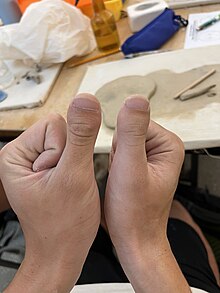Brachydactyly type D
| Brachydactyly type D | |
|---|---|
| Other names | Clubbed thumb,[1] thumb head,[2] short thumb,[3][1] potter's thumb,[1] royal thumb, murderer's thumb,[1] hammer thumb, stubbed thumb,[4] stub thumb[5][6] |
 | |
| Unilateral brachydactyly type D in a 15-year-old female | |
 | |
| X-ray of a regular thumb (left) and a thumb with brachydactyly type D (right) showing distal phalange brachyphalangy of said thumb. | |
| Specialty | Medical genetics |
Brachydactyly type D, also known as short thumb,[3][1] stub thumb,[5][6] or clubbed thumb,[5][6] is a genetic trait recognised by a thumb being relatively short and round with an accompanying wider nail bed. The distal phalanx of such thumbs is approximately two-thirds the length of full-length thumbs. It is the most common type of shortness of digits (brachydactyly), affecting approximately 2% of the population. It is associated with the HOXD13 gene, located on chromosome 2q31.1.[7]
Signs and symptoms
[edit]
Brachydactyly type D is a skeletal condition which exhibits a 'partial fusion or premature closing of the epiphysis with the distal phalanx of the thumb', according to Goodman et alia (1965).[6] J.K. Breithenbecher (1923) found that distal phalanges of short thumbs were one-half the length of full-length thumbs, while R.M. Stecher (1957) claimed that it is approximately two-thirds. The condition may either be unilateral (affecting one thumb) or bilateral (affecting both).[6]
Genetics
[edit]A genetic trait, brachydactyly type D exhibits autosomal dominance and is commonly developed or inherited independently of other hereditary traits. The condition is associated with the HOXD13 gene, which is central in digital formation and growth.[5]
Various other studies supported an autosomal dominant pattern with reduced penetrance.[8]
Hereditary trait
[edit]About 3% of Israeli Arabs had one or two short thumbs, compared with 1.6% among Ashkenazi as well as non-Ashkenazi Jews.[6] However, as the survey's Arab test persons were mainly recruited from a handful of large and closely related clans living in a particular village, said percentage should be "considered with some reservation".
Cases of short thumbs have also been found in Eastern Nepal for Jirel ethnic individuals from their participation in various epidemiologic studies. Some studies included taking radiographs of hands and wrists to examine their skeletal structure. Of the studied sample (which included 2,130 participants; 1,161 female and 969 male), 3.55% were found to have brachydactyly type D.[9]
Terminology
[edit]The condition is known by numerous names including clubbed thumb or club thumb.[10][11] American researcher R.A. Hefner used the terms "short thumb" and "brachymegalodactylism" in 1924,[3] and "short thumb" has continued to be used in a few other studies since then, including the study that defined Rubinstein–Taybi syndrome in 1963.[1] "Stub thumb" is the common term preferred by the online database Online Mendelian Inheritance in Man[5] and was first used in a 1965 study.[6] Stub thumbs have also been called murderer's thumb (allegedly among fortune tellers),[6] hammer thumb, bohemian thumb, and potter's thumb.[5]
References
[edit]- ^ a b c d e f Rubinstein, Jack H. (1963-06-01). "Broad Thumbs and Toes and Facial Abnormalities: A Possible Mental Retardation Syndrome". American Journal of Diseases of Children. 105 (6): 588–608. doi:10.1001/archpedi.1963.02080040590010. ISSN 0002-922X. PMID 13983033.
- ^ Macklin, Madge T. (December 1960). "Inheritance of Glioma: The Genetic Aspects of Cerebral Glioma and Its Relation to Status Dysraphicus". American Journal of Human Genetics. 12 (4 Pt 1): 448–449. ISSN 0002-9297. PMC 1932168.
- ^ a b c Hefner, R. A. (1924-10-01). "INHERITED ABNORMALITIES OF THE FINGERSII. Short Thumbs (Brachymegalodactylism)". Journal of Heredity. 15 (10): 433–439. doi:10.1093/oxfordjournals.jhered.a102395. ISSN 0022-1503.
- ^ Learman, Yaffa; Katznelson, Mariassa Bat-Miriam; Bonné-Tamir, BatSheva; Engel, Joel; Hertz, Marjorie; Goodman, Richard M.; Opitz, John M. (1981). "Symphalangism with multiple anomalies of the hands and feet: A new genetic trait". American Journal of Medical Genetics. 10 (3): 245–55. doi:10.1002/ajmg.1320100308. ISSN 1096-8628. PMID 6272576.
- ^ a b c d e f "OMIM Entry - # 113200 - BRACHYDACTYLY, TYPE D; BDD". omim.org. Retrieved 2019-08-17.
- ^ a b c d e f g h GOODMAN RM; ADAM A; SHEBA C (1965). "A Genetic Study of Stub Thumbs Among Various Ethnic Groups in Israel". Journal of Medical Genetics. 2 (2): 116–21. doi:10.1136/jmg.2.2.116. PMC 1012845. PMID 14295653.
- ^ Temtamy, Samia A; Aglan, Mona S (2008-06-13). "Brachydactyly". Orphanet Journal of Rare Diseases. 3: 15. doi:10.1186/1750-1172-3-15. ISSN 1750-1172. PMC 2441618. PMID 18554391.
- ^ Temtamy, Samia A; Aglan, Mona S (2008-06-13). "Brachydactyly". Orphanet Journal of Rare Diseases. 3: 15. doi:10.1186/1750-1172-3-15. ISSN 1750-1172. PMC 2441618. PMID 18554391.
- ^ Williams, Kimberly D. (2013-09-10). "Non-Syndromic Brachydactyly Type D and Type E Mapped to 7p15 in Healthy Children and Adults from the Jirel Ethnic Group in Eastern Nepal". American Journal of Human Biology. 25 (6): 743–750. doi:10.1002/ajhb.22441. PMC 3968259. PMID 24022874.
- ^ "Google Ngram Viewer". books.google.com. Retrieved 2019-08-17.
- ^ "Google Trends". Google Trends. Archived from the original on 2021-10-31. Retrieved 2019-08-17.
